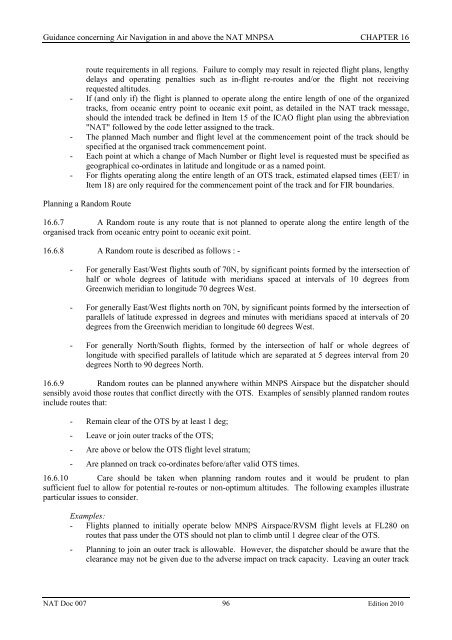World Air Ops | NAT | Doc 007 MNPS Guidance
World Air Ops | NAT | Doc 007 MNPS Guidance
World Air Ops | NAT | Doc 007 MNPS Guidance
Create successful ePaper yourself
Turn your PDF publications into a flip-book with our unique Google optimized e-Paper software.
<strong>Guidance</strong> concerning <strong>Air</strong> Navigation in and above the <strong>NAT</strong> <strong>MNPS</strong>A CHAPTER 16route requirements in all regions. Failure to comply may result in rejected flight plans, lengthydelays and operating penalties such as in-flight re-routes and/or the flight not receivingrequested altitudes.- If (and only if) the flight is planned to operate along the entire length of one of the organizedtracks, from oceanic entry point to oceanic exit point, as detailed in the <strong>NAT</strong> track message,should the intended track be defined in Item 15 of the ICAO flight plan using the abbreviation"<strong>NAT</strong>" followed by the code letter assigned to the track.- The planned Mach number and flight level at the commencement point of the track should bespecified at the organised track commencement point.- Each point at which a change of Mach Number or flight level is requested must be specified asgeographical co-ordinates in latitude and longitude or as a named point.- For flights operating along the entire length of an OTS track, estimated elapsed times (EET/ inItem 18) are only required for the commencement point of the track and for FIR boundaries.Planning a Random Route16.6.7 A Random route is any route that is not planned to operate along the entire length of theorganised track from oceanic entry point to oceanic exit point.16.6.8 A Random route is described as follows : -- For generally East/West flights south of 70N, by significant points formed by the intersection ofhalf or whole degrees of latitude with meridians spaced at intervals of 10 degrees fromGreenwich meridian to longitude 70 degrees West.- For generally East/West flights north on 70N, by significant points formed by the intersection ofparallels of latitude expressed in degrees and minutes with meridians spaced at intervals of 20degrees from the Greenwich meridian to longitude 60 degrees West.- For generally North/South flights, formed by the intersection of half or whole degrees oflongitude with specified parallels of latitude which are separated at 5 degrees interval from 20degrees North to 90 degrees North.16.6.9 Random routes can be planned anywhere within <strong>MNPS</strong> <strong>Air</strong>space but the dispatcher shouldsensibly avoid those routes that conflict directly with the OTS. Examples of sensibly planned random routesinclude routes that:- Remain clear of the OTS by at least 1 deg;- Leave or join outer tracks of the OTS;- Are above or below the OTS flight level stratum;- Are planned on track co-ordinates before/after valid OTS times.16.6.10 Care should be taken when planning random routes and it would be prudent to plansufficient fuel to allow for potential re-routes or non-optimum altitudes. The following examples illustrateparticular issues to consider.Examples:- Flights planned to initially operate below <strong>MNPS</strong> <strong>Air</strong>space/RVSM flight levels at FL280 onroutes that pass under the OTS should not plan to climb until 1 degree clear of the OTS.- Planning to join an outer track is allowable. However, the dispatcher should be aware that theclearance may not be given due to the adverse impact on track capacity. Leaving an outer track<strong>NAT</strong> <strong>Doc</strong> <strong>007</strong> 96 Edition 2010
















